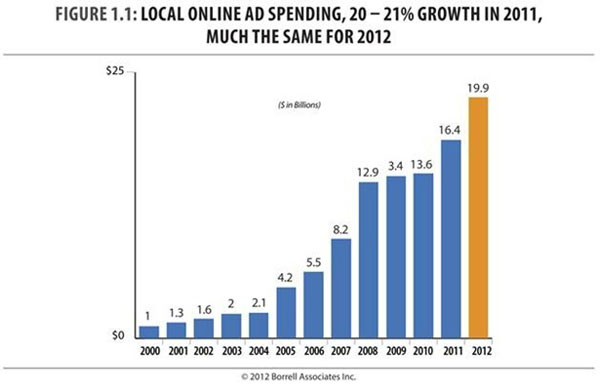A whopping 90 percent of consumers now use search engines when researching products or services in their local area, according to BIA/Kelsey.
Google began more aggressively serving local results in October 2010 due to the shift and growth in local search commerce by consumers and advertisers. Advertisers in turn have boosted their local marketing investment. Borrell Associates forecasts local advertising will grow to reach $19.9 billion in 2012.

Some national brands have already come to realize online visibility has become the most important ingredient in their local marketing mix. Scalable, automated technology can help them overcome slower national competitors and smaller local competitors who lack marketing support, but whether they leverage automation or manually support local stores and offices, national brands should make sure to consider at least five initiatives in any local marketing effort.
1. Leverage a Comprehensive Data Distribution Solution
Google, Bing, Yahoo, Facebook, Foursquare, Twitter, Dex, AOL, Yellow Pages, Citysearch, infogroup, Localeze and hundreds of other sites encourage businesses to submit their location information, not to mention the opportunities available in GPS and mobile devices.
National brands should do this at scale by implementing a data distribution system to ensure customers can find correct information about nearby physical locations, make contact and visit the correct address. Automation technology eases the burden, particularly for national brands supporting many physical locations, enabling new information to be added one time and trigger updates in hundreds of online listings.
2. Claim & Optimize Listings on the Most Widely Used Sites
Ninety-seven percent of consumers search for local businesses online, according to Google. Through Google Places for businesses, the search giant enables brands to ensure local visibility free of charge. Yahoo Local and Bing Local offer similar complimentary listings, and these go a long way toward helping businesses reach potential local customers.
While an automated data distribution system would capitalize on these opportunities and hundreds of others, most searchers will use one of the local services from Google, Yahoo, or Bing. Brands unable to automate a comprehensive data distribution program should at least secure complimentary listings on these three properties for all physical locations.
Once basic listings have been claimed and verified, marketers should go on to optimize these listings based on location, business names and categories, custom fields, and business descriptions, as well as by publishing and optimizing photos and videos of each location. Taking the time to properly optimize these listings won’t just help a brand’s physical locations become more visible on the SERPs; it also helps brands put a friendly face on each location and boost the odds of creating true local engagement with customers.
3. Localize Content With Automation
Like data distribution, managing content across a national brand and numerous locations can weigh on a marketing team and limit overall effectiveness. In fact, according to the CMO Council, 86 percent of national marketers plan to localize their strategy, but only 30 percent of marketers use local automation platforms (October 2011). A local marketing CMS can provide regulated access to corporate, regional or local employees and partners to help national brands spread the workload without sacrificing control.
Maintaining brand integrity and control has long been a top concern for national marketers, but the amount of work to be completed has grown by leaps and bounds. Custom, optimized location web pages with unique URLs are just the first step. Many national brands now provide physical locations with their own mobile location web pages, as well as social and video pages on Facebook, Twitter, YouTube, and other top sites.
4. Manage Ratings & Reviews; Incentivize Happy Customers to Share
Reviews have become vital to the success of national brands and physical locations, but controlling this content and ensuring a consistent brand voice for each location can be tricky. Marketers should never lose track of the fact that consumers and search engines love the authenticity of reviews. Marketers should put a comprehensive program in place to incentivize happy customers to share their positive experiences.
At the most basic level, national marketers should support individual physical locations by claiming pages for each location on prominent review sites, integrating unique review links to corresponding locations, and working with local staff to instill an effective review gathering and management program. Taking the time to create collateral, talk to staff and offer true education about best practices and benefits of local customer reviews can mean the difference between a beloved or loathed reputation for any location.
5. Performance Measurement & Reporting
It isn’t always easy for national brands to secure the budget and resources necessary to effectively boost visibility for its physical locations; so performance measurement and reporting should be part of every campaign. The right approach can provide insights to help continually improve ROI, ensure efforts keep pace with goals, and help justify marketing investments over time.
Measurement and reporting can incorporate a wide range of response types. Call tracking, interactive voice response, corporate reporting dashboards, automated monthly reports by location, marketing analytics integration, click tracking, video views and Facebook leads are just some of the ways national marketers can measure local engagement and return on investment.
Above all else, getting started matters most. Altogether ignoring the need to boost local visibility for its physical locations can spell doom for even the most beloved brands. Ninety-seven percent of consumers now use online media to shop locally, and national marketers should assume a responsibility to support their local storefronts and physical locations.
National brands have an opportunity to leverage locations to dominate local visibility and reach more customers, and these five components should be part of any localized marketing strategy. Automation technology can help marketers save time, scale the effort and support a full national spectrum of physical locations.
This Local Search Marketing Checklist offers a handy guide to help manage the process and insights about what to look for in an automated technology platform.
